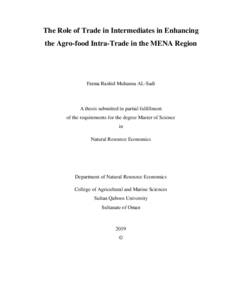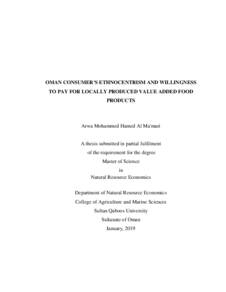Document
The role of trade in intermediates in enhancing the agro-food intra-trade in the MENA Region.
Publisher
Sultan Qaboos University
Gregorian
2019
Language
English
English abstract
The growing trade in intermediate goods and the emergence of Global and Regional Value Chains (GVC, RGC) has touched all sectors, including the agro-food industries. There is strong evidence that these trade developments are taking place within Regional Trade Arrangements (RTAs) where intra-trade is quite significant. The objective of the thesis is to investigate the opportunities and the potential development of the regional value chain in the MENA region focusing on the agro-food trade, and trade in intermediates in particular. The study used trade indices to look at the intra-trade performance in the region and estimated empirically a gravity model to analyze the structural as well as the policy determinants of regional trade in agro-food intermediate products. A panel data consisting of 10 year period and 22 countries were used in the estimation of the model using various estimators, including fixed effect, random effect and Poisson Pseudo-Maximum likelihood (PPML) estimators.
The results show that there is an increase in relative share of total intra-trade during 2007-2016; this performance is still modest compared to other regional groupings. However, the intra-agro-food accounts for more than half of total Arab agro-food trade, a quite significant share suggesting the potential of developing further agricultural trade in the region, possibly within regional value-added chains. The gravity model results indicate that the economic size reflected in the exporter GDP is significant in enhancing regional-intra-trade for processed food only. For the primary agricultural products, the GDP effect is not significant, compatible with the observation that as GDP increases, countries exporter specialize more in processed value added products and less in primary low value added agricultural products. The distance variable is quite significant in all models and its negative effect is more important in primary food than processed food due to its more perishable nature.
The results related to the performance of sub-regional trade arrangements show that only the GCC–bloc trade had a positive and significant effect on the bloc-intra-trade due to its deeper economic integration form. The other trade blocs (Maghreb and Mashreq) performed poorly in enhancing intra-trade of both primary and processed agricultural products. Trade facilitation, reflected in the time required to clear customs for exports and imports was found to be a highly determinant of bilateral trade. It is estimated that a 1 percent increase in the time to export (import) would lead to a 64% (36%) loss in the value of bilateral trade of processed agricultural products.
The time to export and import is directly linked to investment in transport logistics, port infrastructure, custom procedures and other trade facilitation indicators, in which the Arab region is scoring poorly. Reducing trade cost through better regional connectivity would help building trade corridors and enhance RVCs.
Member of
Resource URL
Arabic abstract
نمو التجارة في السلع الوسيطة وظهور سلاسل القيمة المضافة العالمية والإقليمية أثرت على كل القطاعات بما فيها القطاع الزراعي والغذائي. وهناك أدلة قوية على أن هذه التطورات التجارية تجري ضمن اتفاقيات التجارة الحرة الإقليمية حيث التجارة البينية متطورة إلى حد بعيد. الهدف من هذه الأطروحة هو التحقيق في إمكانية تنمية سلسلة القيمة المضافة الإقليمية في منطقة الشرق الأوسط وشمال أفريقيا، مع التركيز على تجارة الأغذية والمنتجات الزراعية، وبالخصوص التجارة في المواد الوسيطة. استخدمت الدراسة الأرقام القياسية للتجارة لتقييم أداء التجارة البينية في المنطقة، ونموذج الجاذبية التحليل العوامل الهيكلية والسياسات التجارية التي تؤثر في التجارة البينية للمنتجات الزراعية والغذائية الوسيطة. ولهذا الغرض استخدمت بيانات سنوية لاثنين وعشرين (22) بلدة عربيا الفترة عشر سنوات لتقدير العلاقة البينية باستعمال نموذج ذي الأثر الثابت والعشوائي ونموذج ب-ب-مل.
Category
Theses and Dissertations


